Saxmundham
See the photographs of the Saxmundham
to Aldeburgh branch line stations.
Saxmundham has maintained its
position as quite an
important town in
eastern
Suffolk with its rail station, market and its position for many years
on
the arterial road to Yarmouth, the A12. Now by-passed to avoid its
infamous
bottleneck of ancient buildings, it retains several notable examples
of
lettering on its walls.
 2001
2001
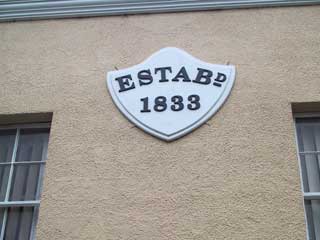 2006,
photo courtesy
Andrew Smith
2006,
photo courtesy
Andrew Smith
Flick & Sons, estate agents once bore an impressive
rounded-topped relief
shield: 'ESTABD. 1833' with the
'B' bold in relation to the roman remainder. Unfortunately (as shown in
the second image) in 2006 the shield was replaced with a (possibly
plastic) version with much more regular characters. This is Ashford
House in High Street and it's a curiosity only because it eschews the
numbering system: the 'Gibbs' step (see below) is at no. 26 and on the
other side of Flick's offices are 26a, then 28.
From the Saxmundham Town Council website (see Links):
'In the early part of the 19th century, the jeweller and clockmaker
Jerome Bright occupied Ashford House and it is here that his son Henry
Bright, the painter, is said to have been born in 1810. In about 1840,
two of Jerome Bright's daughters married Isaac and James Ashford who
took over the premises and set up their antiques and furniture making
business. The remainder of the Bright family moved to Park Lodge in
South Entrance. The Ashford family traded there until the 1980s. Flick
& Son estate agents and auctioneers moved to Ashford House in 1983
having been established in the town for 150 years prior to this.'
Flick & Sons stands opposite the
Bell Hotel with its long cartouche
bearing
its name and the town in serif caps, in 200 so weathered that the
signwriters
font outlines alone preserve much of the characters towards the right.
We
wonder if the two white trapezium shapes between first floor windows
cover
up earlier lettering?
 2001
2001
And below is Andrew Smith's image of the hotel after a
facelift in
2004. The 'trapeziums' now have their pair of tails restored and more resemble scrolls, once possibly
carrying lettering such as "Wines & Ales" and "Good Food"?
 2004
2004
Below: the Bell Hotel in summer
2015 – they have ‘boutiqued’ it (brown walls on the lower story), but
the main Bell Hotel lettering is the same.
 2015
2015
 (2006
photos courtesy Andrew Smith)
(2006
photos courtesy Andrew Smith)  2014
2014
Above: the old Post Office at 22 High
Street, Saxmundham with the raised lettering in a very poor state.
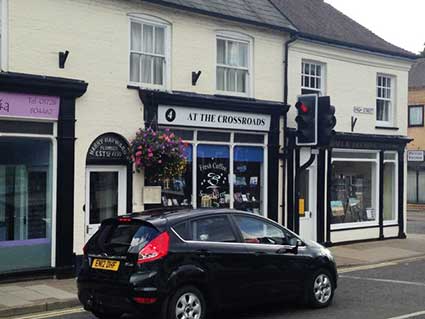
 2014
images
2014
images
Number 4 High Street has a door with modern leaded lettering above it:
'HARRY HAYWARD, PLUMBER, ESTBD. 1770'.
And right on the road's bottleneck, next to the old Post Office is a
business of the sort becoming much rarer in the bigger towns where huge
B&Q citadels stand with superstores as gateways to the
conurbations:
'W. WELLS & SON
IRONMONGERS.'
[UPDATE 15.4.2011: Andrew Smith
reports that this is now "The Store" clothes shop: they have restored
the whole shop and repainted the new shop name in similar brown
capitals.
And the Ransomes plaque is still there.]
 2001
2001
On the wall facing the road, a cast iron plate
boasting the
company's
dealership in the region's famous cast iron products:
'RANSOMES' PATENT PLOUGHS AND IRONS SOLD HERE'. When was the last time
a
customer came into the shop demanding these? It's also worth indulging
in a bit of pedantry concerning that misplaced apostrophe: shouldn't it
be "Ransome's" as it was the firm founded by Robert Ransome? One
assumes that, as with "Woolworths", "Sainsburys" and "Tescos", such
large company names are colloquialised as a sort of possessive plural,
so the possessive apostrophe below follows "Ransomes". The local
history resource for this company at University of Reading uses this form. See our Ransomes page
for the only trace of the name on a building near the former huge
riverside foundry in Ipswich.
 2001
2001 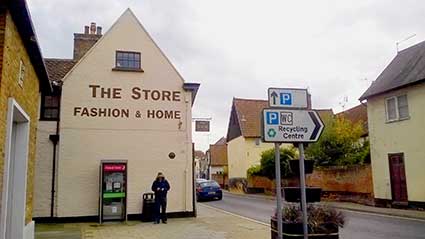 2015
2015
At right: 'The Store' in 2015, which was W. Wells &
Son ironmongery shop – they have rather nicely emulated the old
lettering. There is only one 'phone box now.
At the front of this shop we find raised or
repoussé lettering:
'IRONMONGERS
... FURNISHING ... W.WELLS & SON'
The first two in an art nouveau relief frame
with a font to match.

 Photos courtesy Andrew Smith
Photos courtesy Andrew Smith
Gibbs doorstep
 2015
2015
This striking 'Gibbs' mosaic is in the doorway of what was most
recently The Cotton Tree interior design shop, 26 High Street; before
them it was empty for many years. And before that it was Martins’
outfitters (in the 1980s/early 90s).
 Photo
courtesy David Kindred
Photo
courtesy David Kindred
David Kindred's seemingly inexhaustible supply of period
photographs (see 'Kindred Spirit' on our Links
page) yields this view of High Street in around 1900. The 'pinch' in
the main road is clearly seen in the left background. Flick's dated
shield can be seen in the centre and the nearer shop, no. 26, shows Mr
Silas Gibbs in white apron outside his named premises.
[UPDATE 1.11.2015: "The old
photo of the High Street is great – I must point out the railings in
front of the Market Hall where the gent is standing, and the shop on
the extreme left is H.G. Crisp which of course is still there but not
run by Mr Crisp. I further note the Bell on the hotel sign hanging
quite far into the road, and the ‘LLIS’ just showing on the shop near
what you describe as the ‘pinch’. This had been a Lloyds bank more
recently with a more substantial stone facing which no doubt you’ve
examined – there was some nice lettering on the cornice which was
removed so now you can only see an outline.
The shop where the dated shield is situated is called Ashford
House which became occupied by Flick in 1983, before that is was
Ashford’s furniture store – my parents remember going in there to look
at furniture after they were first married in the 1950s." More info
about the historic shops on the Saxmundham Town Council website [see Links]. – Andrew
Smith]
The
pump
Iron founding was a major
industry in parts of 19th
and 20th Century
Suffolk. As well as the Ipswich-based Ransome companies,
Garretts of nearby Leiston created a small industrial town in the heart
of the countryside. A fine, well-preserved town pump in cast iron
stands not far from the shop above.

 Photos courtesy
Andrew Smith
Photos courtesy
Andrew Smith
The relief text picked out in gold on the pump
reads:
'PRESENTED BY W. LONG ESQR.
A.D. 1838'
[UPDATE
May 2010:
"Regarding the pump in Saxmundham, which you feature – in 1868 W. Long
was the
local lord of the manor, whose seat was Hurts Hall.
From the Saxmundham Town Council website (see Links):
The Long family have been associated with Saxmundham from the 17th
century, originally coming from Wiltshire; there are several memorials
to the Long family in the parish church. Samuel Long (1638-1683) was
appointed secretary to the Jamaica Commissioners immediately after the
conquest of that island, and on his return to England purchased Hurts
Hall and the manor. The much older sub-manor of the Swan family was
absorbed into the Long manor in about 1778. The Rt. Hon. Sir Charles
Long was MP for Dunwich and created Baron Farnborough in 1826.
According to the 1840 census, William Long lived in Hurts Hall with his
wife Ellenor, their five children, a governess, five male servants and
ten female servants. It was William who built the Market Hall
(originally a corn exchange), the school rooms next to the parish
church, and he donated the Town Pump. Hurts Hall was the seat of the
Long family until the 1950s.
Regards, Dick Williams in Cheltenham" whose excellent Village Pumps
website (see Links)
is not to be missed.]

 2015 pump images
2015 pump images
On the base in a
rectaugular frame:
'GARRETT & SON
MANUFACTURERS
LEISTON'


By 2015 the lettering on the body of the pump
has been painted over in black.

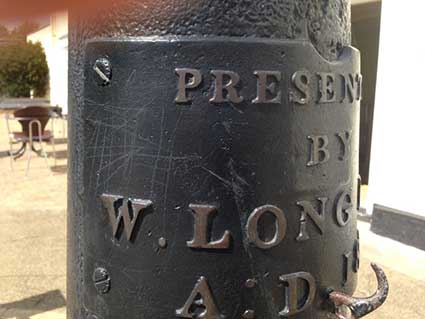
Let's look at the Market Hall (below left) which stands hard up
against The Bell
Hotel.

Here we find atop the fascade the large town emblem
incorporating the Long family (as commemorated on the town pump)
coat of arms, wheat designs, and
inscription 'DIEU ET MA PATRIE': 'God and my country'. We'll get the
text on that small tablet below the crest at some point, too. It is
perhaps of interest that this is an uncommon motto in Britain; the
other notable use is by the noble family of Marton of Caperwray Hall in
Lancaster which is of Norman origin and great antiquity.
 (Photographs courtesy Andrew Smith)
(Photographs courtesy Andrew Smith)
15.4.2011 - A contribution from
Andrew Smith, designer of the Saxmundham
Town
Council website (see Links; they have a page
on Saxmundham Museum):
'I can’t remember if I’ve ever sent you the old pic I have
of the Wine shop in Saxmundham – the pic is from the turn of the
Century (1900 that is) – that’s my guess, but it may be a
little older than that. Interestingly it is called H Waller & Sons
and I have Wallers in my family.
Interestingly, it was a Threshers wine shop until about 2 years ago
– it was a “Local store” for a while and then closed.
It’s been empty for a while but people have been working on it
now for several weeks. They’ve taken a lot of care with the
façade, but now obliterated the
“Peter Dominic” painted lettering. So I got a pic for your
collection and will try to get one when it’s finished.'
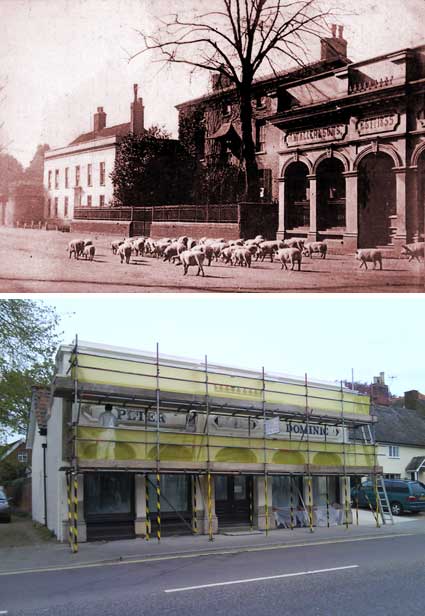

(Photographs courtesy
Saxmundahm Museum and Andrew Smith)
The rather wonderful sepia image (above) of a time when a herd of pigs
could stride purposefully down the middle of the A12 (although it may
not have been called that then) shows two of the three of the
cartouches on the fascade. This confection of romanesque arches and
square half-columns has always drawn the eye in Saxmundham's main
street. We well remember it as a Peter Dominic off licence from over
thirty years ago. Many thanks to Andrew.

 2001
2001
 2006,
photo courtesy
Andrew Smith
2006,
photo courtesy
Andrew Smith 2001
2001 2004
2004 2015
2015 (2006
photos courtesy Andrew Smith)
(2006
photos courtesy Andrew Smith)  2014
2014
 2014
images
2014
images 2001
2001 2001
2001  2015
2015
 Photos courtesy Andrew Smith
Photos courtesy Andrew Smith 2015
2015 Photo
courtesy David Kindred
Photo
courtesy David Kindred
 Photos courtesy
Andrew Smith
Photos courtesy
Andrew Smith
 2015 pump images
2015 pump images




 (Photographs courtesy Andrew Smith)
(Photographs courtesy Andrew Smith)
